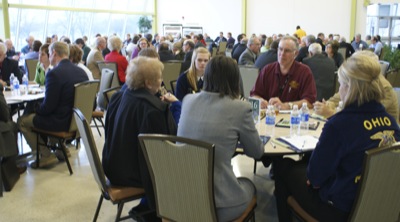Saturday, March 26th, 2011
Money tripled for lake dredging
By Nancy Allen
GRAND LAKE - The Ohio Senate and House have approved tripling the amount of money set aside for dredging and related activities on Grand Lake this year.
An additional $750,000 will be directed to the lake due to an amendment proposed by Sen. Keith Faber, R-Celina.
Faber on Friday said the funds could be used to hire additional personnel to work more shifts, build areas to place lake sediment and purchase riprap (large rocks) to construct rock perimeters where lake sediment could be pumped to build islands.
Faber called the lake a "tremendous asset" to the region and thanked Ohio Department of Natural Resources Director David Mustine for locating the funding within ODNR's budget.
"We allocated a larger part of dredge money for Grand Lake from unallocated state dredge funds that weren't being used," Faber said. "They were looking at spending $300,000 this year (on Grand Lake dredging). This will effectively triple that."
There's also a possibility the funds could be used by ODNR to hire private dredges to go to work on the lake. Last year, former state Rep. Jim Zehringer of Fort Recovery and Faber met with officials from the Ohio Aggregates and Industrial Minerals Association (OAIMA), which uses dredges to mine various commodities.
The OAIMA is a trade association that represents all of the state's mining operations, except coal. Its commodities include mostly construction materials, both natural and manmade, such as sand, gravel, crushed limestone, salt, clay, lime, cement and recycled concrete.
Faber said it would be up to ODNR to make a decision to hire private dredges.
"The goal by me and supported by director Mustine is we need more dredging in Grand Lake, and one of the limiting factors in improving dredging in Grand Lake has been funding," Faber said.
Another factor is the state is running out of places to put sediment dredged from the lake.
Grand Lake St. Marys State Park Interim Manager Brian Miller said his office will put a plan together soon on how to spend the $750,000.
Miller said OAIMA representatives are interested in analyzing sediment samples from the lake to determine if it contains anything useful, such as sand or the nutrient-rich sediment itself. If the lake sediment can be moved out of the area and sold as a fertilizer, that would mean fewer dredge material relocation areas would be needed.
"Once they get the samples, then they could come up with a comprehensive plan on how to dredge," Miller said.
Miller said the state already plans to operate three dredges this year to remove 200,000 cubic yards of sediment from the lake.
Studies show the decades-long accumulation of phosphorous-rich sediment in the lake contributes to the growth of toxic blue-green algae, which nearly shut down the lake last summer. In some parts of the lake, the sediment has accumulated five feet or more.
Miller noted that an ODNR planner determined that if four feet of sediment were dredged from the lake, it would amount to 84 million cubic yards. It would produce a tower of sludge 3,550 feet high if it were pumped into the 14-acre OSU stadium.
